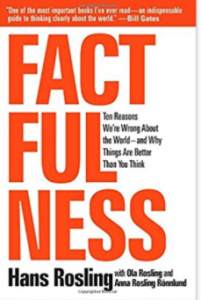
The world is gloomy as things are better than we think


In 2015, Swedish professor of international health the late great Hans Rosling, asked an audience that included heads of state, titan of industry and a former UN secretary-general three multiple choice questions about poverty, population growth and Vaccinations rates, which resulted in scoring worse than Chimpanzees, doing just as badly as other audiences he had quizzed. Rosling’s ability to convey complex data in an entertaining and interesting manner, with his belief that world was in much better shape than people realise. “Every group of people I ask thinks the world is more frightening, violent and hopeless, more dramatic than it really is”. Hans Rosling tells the story of “the secret silent miracle of human progress”.
Rosling’s extraordinary ability to bring data to life and his message in Factfulness is although optimistic but a simple one as he hates description and he argues, his views are rooted firmly in reality. As a “possibilist”, he is convinced that a dispassionate assessment of the facts has a calming effect because it reveals a world less divided and more prosperous than we realise.
With his son and daughter-in-law, Ola and Anna, co-authors of the book, he developed software to convey complex data over time by representing countries as moving bubbles scaled to population size.
Rosling’s audience in Davos did not know that the world’s average life expectancy is 70 and 88 percent of children are vaccinated against diseases, and in 2100 there will be 2bn children below the age of 15 – the same number as today. Apart from Africa, the fertility rates have fallen so far that populations have stabilised almost anywhere on Earth. According to Rosling, Women in Muslim Bangladesh have fewer children than in Christian atheist Sweden.
When he tested on thousands of people around the world, for the basic fact to know about life on Earth, only 7 per cent got it right.
He also disputes the idea that there is a ”gap” between the rich world and the developing world, a view he calls 50 years out of date.
A snapshot of 1965 and 2017, showing babies per woman against children surviving to age five, in 1965, most of the world, including India and China is huddled towards the bottom left-hand corner with high birth rates and low survival rates, But by 2017, almost all have moved to the top right, where birth rates have fallen and child survival rates sharply improved. Only 6 per cent of the global population, living in 13 countries mostly locked in civil war, reaming stuck in the box marked “developing “.
For our distorted picture of the world, the media should be blamed for their report on tragedies such as starvation, war and school shootings, and from charities that accentuate the negative.
Rosling devoted a chapter stating only 4.2m babies died last year, calling the number “beautifully small”, as he compares to the 14.4m dead babies in 1950. We have made a huge progress.
“The world cannot be understood without the numbers and it cannot be understood by numbers alone”.
Factfulness: Ten Reasons We’re About the World – and Why Things are Better Than You Think by Hans Rosling Sceptre £12.99. Flatiron Books $27.99, 352 pages
